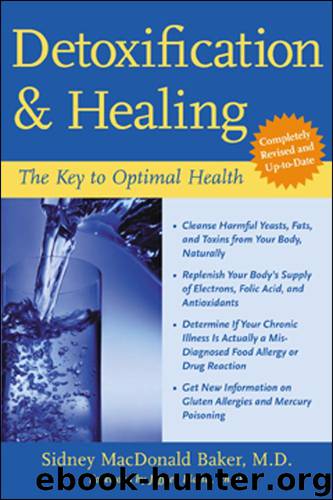Detoxification and Healing: The Key to Optimal Health by Baker Sidney MacDonald

Author:Baker, Sidney MacDonald [Baker, Sidney MacDonald]
Language: eng
Format: epub
Publisher: McGraw-Hill Education
Published: 2003-09-10T16:00:00+00:00
6
Heavy Metals
Mercury
IN THE 1950S Emily Marshall had worked in a medical school research lab where they floated heart patients on a bed of quicksilver (mercury). The idea was to detect heart problems by measuring tiny body movements generated by the actions of the heart.
Mercury is quick in the sense that it offers little resistance to the movement of a body suspended on its surface. It is dense; lying on its liquid surface leaves one barely immersed. Emily and her coworkers in the research group played with their vat full of mercury as I did as a child when supplied with a few liquid metallic beads from a broken thermometer.
We all tend to become childlike when confronted with the paradoxical properties of quicksilver. A liter (about a quart) of water weighs one kilogram (2.2 pounds). The same volume of mercury weighs thirteen times more. As it is heavy in that sense, so it is light in the sense of its silvery color and its quick movements. Of the metallic elements such as iron, tin, lead, gold, and silver, quicksilver is the only one that is a liquid at room temperature. Like all elements, and like water, its liquid form takes to the air in the form of an invisible vapor. Mercury vapor is a natural part of the earth’s atmosphere; every day you breathe in a tiny amount—about one microgram or one-thousandth of a thousandth of a gram. (A quarter teaspoon of water weighs about a gram.)
Emily came to me with an assortment of symptoms for which different doctors had given different diagnostic names. The question of her past mercury exposure only came up when she and I began to scour the possible explanations for her not feeling well. I raised the question of whether the mercury in her dental fillings could be causing any or all of her troubles. This sparked her memory of having worked in the cardiology lab years ago and caused us to wonder if she might be still carrying a lot of mercury in her body.
Emily and her coworkers would have inhaled comparatively huge amounts of mercury vapor. Their exposure came more from the vapor than from sticking their hands and arms into the tub in which the patients were placed for the tests. That’s because liquid mercury does not enter the blood or body tissues via the skin or the intestine. Mercury vapor enters the blood via the lungs. You have never worked in a place with huge amounts of mercury vapor in the air. Still, Emily’s story will be of interest to you for several reasons.
First, it reveals the long-standing medical tolerance for the use of mercury and an indifference to wondering about where to draw the line between what is safe and unsafe. The cardiologists in charge of the research lab were not concerned about any danger to themselves, their patients, or their staff. In the 1950s, and even later, doctors used mercury-containing medications. One that I remember from my training in the
Download
This site does not store any files on its server. We only index and link to content provided by other sites. Please contact the content providers to delete copyright contents if any and email us, we'll remove relevant links or contents immediately.
| Acupuncture & Acupressure | Aromatherapy |
| Ayurveda | Chelation |
| Chinese Medicine | Energy Healing |
| Healing | Herbal Remedies |
| Holistic | Homeopathy |
| Hypnotherapy | Massage |
| Meditation | Naturopathy |
| Reference |
Inner Engineering: A Yogi's Guide to Joy by Sadhguru(6455)
The Power of Now: A Guide to Spiritual Enlightenment by Eckhart Tolle(5356)
Fear by Osho(4502)
Ikigai by Héctor García & Francesc Miralles(3909)
The Art of Happiness by The Dalai Lama(3855)
The Ultimate Bodybuilding Cookbook by Kendall Lou Schmidt(3716)
Yoga Therapy by Mark Stephens(3577)
The Little Book of Hygge by Meik Wiking(3453)
Why Buddhism is True by Robert Wright(3294)
The Healing Self by Deepak Chopra(3274)
Being Aware of Being Aware by Rupert Spira(3096)
The Hatha Yoga Pradipika (Translated) by Svatmarama(3087)
Shift into Freedom by Loch Kelly(3036)
Wild Words from Wild Women by Stephens Autumn(2944)
Work Clean by Dan Charnas(2904)
Happiness by Matthieu Ricard(2892)
More Language of Letting Go: 366 New Daily Meditations by Melody Beattie(2862)
Yoga Body & Mind Handbook by Jasmine Tarkeshi(2754)
Why I Am Not a Feminist by Jessa Crispin(2591)
